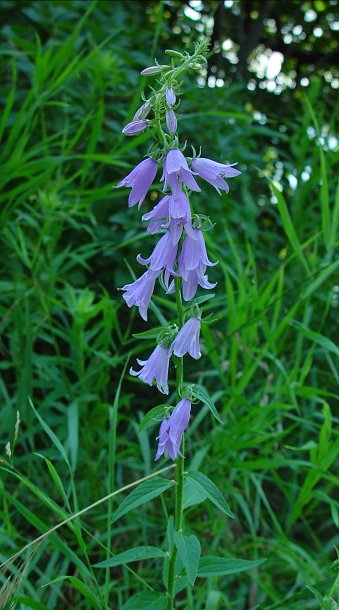Campanula rapunculoides L.
Creeping Bellflower

Introduced
CC = *
CW = 5
MOC = 11
© DETenaglia
Campanula rapunculoides L.Creeping Bellflower | |
 |
Introduced CC = * CW = 5 MOC = 11 |
© DETenaglia |
|
Family - Campanulaceae Habit - Robust perennial forb, colonial from long-creeping rhizomes, with fleshy roots. Stems - Strongly ascending to erect, to 1 m, usually unbranched, glabrous or sparsely hairy toward the tip, often purplish below.
Leaves - Basal leaves with a long, slender petiole to 10 cm long, the blade 2-7 cm long, 1.5-3.5 cm wide, broadly ovate, rounded or cordate at the base, angled to a sharply pointed tip, the margins somewhat unevenly, relatively coarsely, and sharply toothed, the surfaces minutely roughened, especially at and near the margins. Stem leaves alternate, gradually reduced from near the stem base to the tip, short-petiolate to sessile, the blade 2-5 cm long, those of the lower leaves ovate to ovate-triangular, those of the upper leaves narrowly lanceolate, otherwise similar to the basal leaves.
Inflorescence - Relatively dense racemes, the flowers mostly oriented toward 1 side, solitary at each node and usually nodding, the lowermost bracts more or less leaflike but most of the bracts reduced. Pedicels to 1 cm long in flower, elongating in fruit to 6 cm, typically glabrous.
Flowers - Calyx tube 4-5 mm long at flowering, elongating as fruit matures, the lobes 5-7 mm long, 1.5-2.0 mm wide, lanceolate. Corollas bell-shaped, the tube 9-13 mm long, sparsely pubescent internally, glabrous externally, the lobes 7-10 mm long, glabrous at the tip, blue to purple. Style 18-20 mm long, included within or barely exserted from the corolla, straight or nearly so in open flowers, the stigma 3-lobed. Stamens 5. Filaments abruptly broadened and flattened at base, white, to 4 mm long, pubescent at broadened base. Anthers yellow, curled, 5-6 mm long. Ovary inferior, 3-locular, ovules many, placentation axile.
Fruits - Capsules 5-8 mm long, 5-6 mm in diameter, nearly spherical, 3-locular, nodding, dehiscing by 3 round pores near the base; seeds 0.8-1.2 mm long, 0.8- 1.0 mm wide, flattened, usually with a thickened margin. Flowering - June - October. Habitat - Old homesites, crop fields, roadsides, railroads. Origin - Native to Eurasia. Lookalikes - Distantly, Campanula americana. Other info. - This plant is quite striking, with inflorescences that can be half the length of the entire plant. It is relatively uncommon in Missouri, and is found mostly in the northwestern quadrant of the state. Its North American distribution is scattered across the northern half of the U.S. and into Canada. Although the plant is widely cultivated for its beautiful inflorescences, its long-creeping rhizomes contribute a degree of aggressiveness which may be unwelcome in some situations. Photographs taken in Marquette, MI., 7-21-02 (DETenaglia); also in Nederland, Boulder County, CO, 8-5-2017, and near Goodrich, Genesee County, MI, 7-4-2022 (SRTurner). |